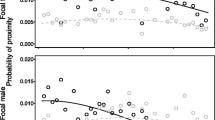Abstract
The play behavior of Japanese macaque infants was studied for 6 months at Arashiyama, Japan. Three types of play were identified. The first (solitary play) was observed in five to 12-week old infants. The second type of play (parallel play) was observed in infants from 12 to 21 weeks old. After the 12th week, the third type of play (associate play) was seen. At this point the infants seldom played without partners. It is in associate play that dominant and submissive behavior may be seen, and from which dominance relations may be assumed. It is said that the rank of a 12 week-old infant parallels that of its mother.
Similar content being viewed by others
References
Fady, J. C., 1969. Les jeux sociaux: le compagnon de jeux chez les jeunes. Observations chezMacaca irus.Folia primat. 11: 134–143.
Harlow, H. F., 1962. The heterosexual affectional system in monkeys.Amer. Psychol., 17: 1–9.
——, 1962. Social deprivation in monkeys.Sci. Amer. 207: 137–146.
Hazama, N., 1962. On the weight-measurement of wild Japanese monkeys at Arashiyama.Bull. Iwatayama Monkey Park, No. 1. (in Japanese) Partly translated into English in 1964 with the following title: Weighing wild Japanese monkeys in Arashiyama.Primates 5: 81–104.
Kawabe, S., 1965. A study of Japanese monkeys raised in isolation—Development ofQuol andRika for the first 8 months after their birth. In:Saru (Monkeys and Apes),S. Kawamura &J. Itani (eds.), Chuokoron-sha, Tokyo, pp. 455. (in Japanese)
Kawamura, S., 1958. Matriarchal social ranks in the Minoo-B troop: A study of the rank system of Japanese monkeys.Primates 1: 149–156.
Koford, C. B., 1963. Rank of mothers and sons in bands of rhesus monkeys.Science 141: 356–357.
Koyama, N., 1966. Rank and play of a wild Japanese monkey troop in Arashiyama. Osaka City University (Unpublished master thesis) (in Japanese)
——, 1967. On dominance rank and kinship of a wild Japanese monkey troop in Arashiyama.Primates 8: 189–216.
——, 1970. Changes in dominance rank and division of a wild Japanese monkey troop in Arashiyama.Primates 11: 335–390.
Mason, W. A., 1960. The effects of social restriction on the behavior of rhesus monkeys: 1 Free social behavior.J. comp. Physiol. Psychol. 53: 582–589.
Nakajima, K., 1958. A wild troop of Japanese monkeys in Arashiyama.Yaen, 1. (in Japanese)
--, 1964. The lineage of Arashiyama troop. (mineo)
Rosenblum, L. A., 1961. The development of social behavior in the rhesus monkey. Doctoral dissertation, Univ. of Wisconsin. University Microfilms, Ann Arbor, Michigan, No. 61-3158.
Sade, D. S., 1967. Determinants of dominance in a group of free-ranging rhesus monkeys. In:Social Communication among Primates,S. A. Altman (ed.), Univ. of Chicago Press, Chicago, pp. 99–114.
Yerkes, R. M &J. H. Elder, 1963. Oestrus, receptive, and mating in chimpanzee.Comp. Psychol. Monogr. 13: 1–39.
Author information
Authors and Affiliations
About this article
Cite this article
Norikoshi, K. The development of peer-mate relationships in Japanese macaque infants. Primates 15, 39–46 (1974). https://doi.org/10.1007/BF01749591
Received:
Accepted:
Issue Date:
DOI: https://doi.org/10.1007/BF01749591




